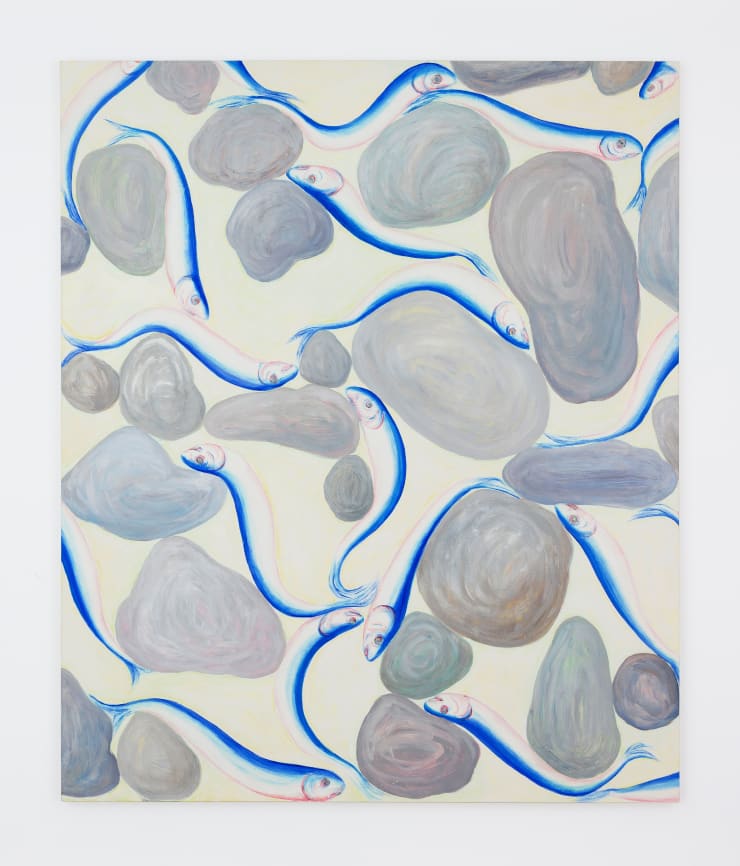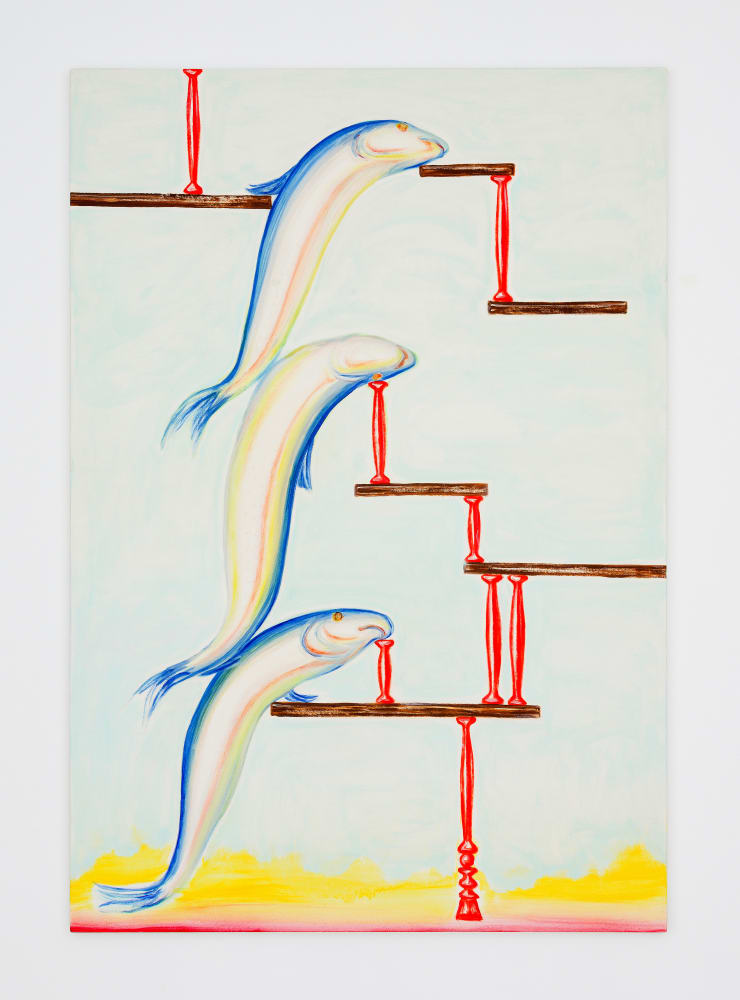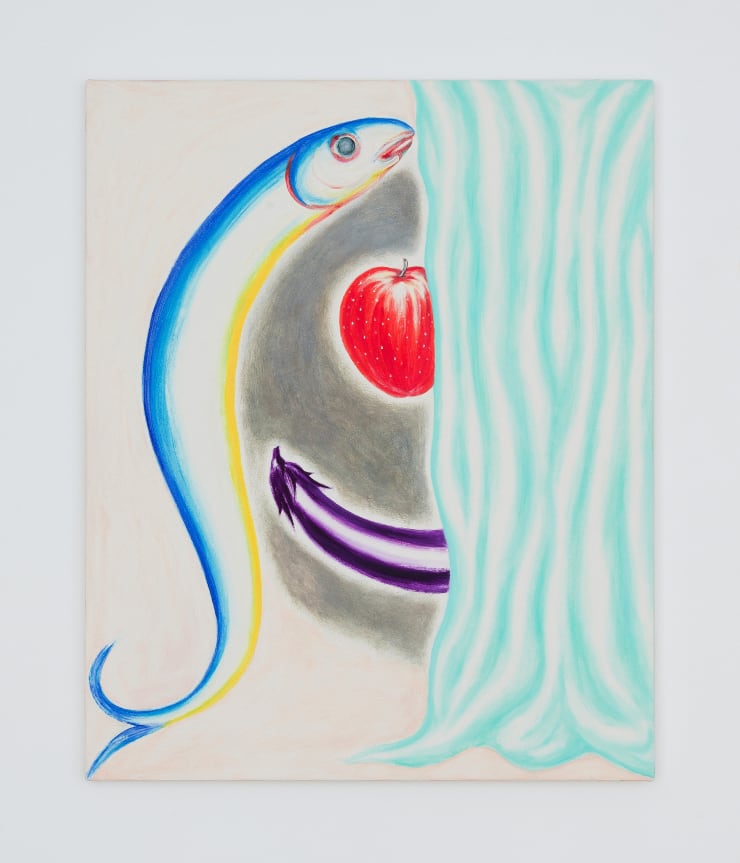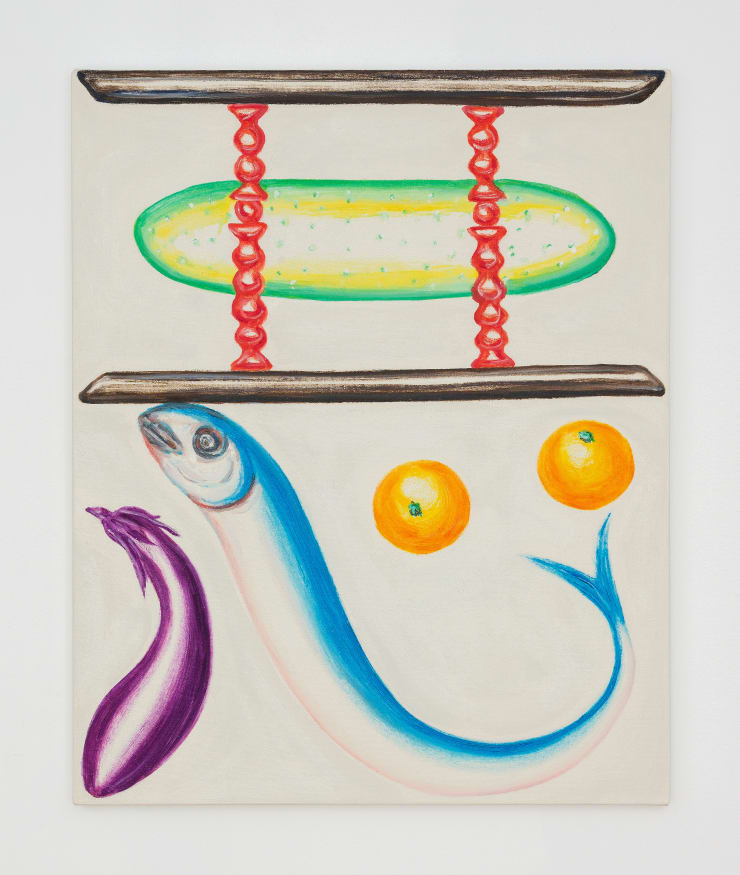Shigeru Hasegawa: painting
6917 Melrose Avenue Los Angeles CA 90038
Open hours: 12PM-7PM
–– Shigeru Hasegawa
At our Melrose Avenue gallery, Nonaka-Hill is delighted to present painting, selected work by Shigeru Hasegawa (Japan, b. 1963), marking his first solo exhibition outside of Japan. Latently informed by Japanese ukiyo-e, manga, and various Western painting traditions, Hasegawa’s idiosyncratic works feature a recurring cast of fruits, vegetables, fish, and other objects. Arranging them into formations against the picture plane, Hasegawa makes playfully concentrated paintings, executing each one with formal economy. Receiving his art training in Japan, Germany, and Holland in the 1980s and 1990s, Hasegawa was exposed to a wide range of formative influences, which for the past two decades, he has diffused into his unusually fresh paint handling and surfaces. His orchestration of objects in stacks and patterns thus take on a provisional and animated appearance, as if they could fall apart or rearrange themselves at will. In two paintings on view, vegetables and fish assume the shapes of various Kanji, Chinese-derived characters in the Japanese writing system, one of which features two swollen eggplants aligned to signify “person.” In several other paintings, his formations resemble a schematic figure, somewhat similar to how 16th century artist Giuseppe Arcimboldo’s rendered human subjects as combinations of fruits and vegetables. Such allusions to the transience of life, as memento mori and vanitas, abound in Hasegawa’s work. But in the same spirit as Arcimboldo, his work possesses a whimsical obscurity as to what each part distinctly symbolizes. That a kindred use of vegetables can be found in Itō Jakuchū’s 18th century painting, Scene of Buddha’s Nirvana by Vegetables, has not been lost on Hasegawa either. He knows that even the Buddha can be represented by a radish. Yet, his paintings are not limited to such readings because his symbols are fugitive, and his means of their articulation in as few brushstrokes as possible, is his focus beyond motifs.
This provisional nature also finds itself in how Hasegawa refers to the beginning of a painting, conceptualizing it as a confrontation with a screen or mirror. In his approach to distill his ideas into paint, it is similar to the Zen discipline of Zazen, a practice whose objective is its own process, beyond it being seen by the public. In one of his paintings in the exhibition, one sees a grey-blue expanse in its center framed by many overlapping cucumbers. The expanse is vaguely in the shape of a human head, in which one can maybe discern facial features. It could be a suggestion for the way one looks, or Hasegawa looks, at the inner-self––an attempt to become nothing, like Zazen.
Shigeru Hasegawa’s solo exhibitions include Satoko Oe Gallery, Tokyo, Japan (2022 – 2019); memento mori-kun, Shouonji-temple,Tokyo (2021); Galleria Fienarte, Aichi, Japan (2020); Open Studio 49–What is the motif?! Fuchu Art Museum, Tokyo, Japan (2010); and group exhibitions at Museum Haus Kasuya, Kanagawa, Japan (2022); Toyota Municipal Museum of Art, Aichi, Japan (2019); Aichi Prerfectural Museum of Art, Aichi, Japan (2019); Okazaki Mindscape Museum, Aichi, Japan (2013); The National Museum of Art, Osaka, Japan (2010); National Gallery of Modern Art, New Delhi, India (2005)
 Shigeru HasegawaOil on cotton76 3/8 x 63 3/4 in
Shigeru HasegawaOil on cotton76 3/8 x 63 3/4 in
194 x 162 cm Shigeru HasegawaThe Sower (female), 2020-2021Oil on cotton63 3/4 x 51 1/8 in
Shigeru HasegawaThe Sower (female), 2020-2021Oil on cotton63 3/4 x 51 1/8 in
162 x 130 cm Shigeru HasegawaThe Sower (male), 2020Oil on cotton63 3/4 x 51 1/8 in
Shigeru HasegawaThe Sower (male), 2020Oil on cotton63 3/4 x 51 1/8 in
162 x 130 cm Shigeru HasegawaOil on cotton63 3/4 x 44 1/8 in
Shigeru HasegawaOil on cotton63 3/4 x 44 1/8 in
162 x 112 cm Shigeru HasegawaOil on cotton31 5/8 x 25 5/8 in
Shigeru HasegawaOil on cotton31 5/8 x 25 5/8 in
80.3 x 65.2 cm Shigeru HasegawaOil on cotton20 7/8 x 17 7/8 in
Shigeru HasegawaOil on cotton20 7/8 x 17 7/8 in
53 x 45.5 cm Shigeru HasegawaOil on cotton28 3/4 x 24 in
Shigeru HasegawaOil on cotton28 3/4 x 24 in
73 x 60.8 cm Shigeru Hasegawa堀損樽−婆痴軽 参 horizontal - vertical three, 2012Oil on cotton51 1/4 x 38 1/4 in
Shigeru Hasegawa堀損樽−婆痴軽 参 horizontal - vertical three, 2012Oil on cotton51 1/4 x 38 1/4 in
130.3 x 97 cm Shigeru HasegawaMedusa, 2020Oil on cotton31 5/8 x 25 3/4 in
Shigeru HasegawaMedusa, 2020Oil on cotton31 5/8 x 25 3/4 in
80.3 x 65.5 cm Shigeru HasegawaOil on cotton17 7/8 x 15 in
Shigeru HasegawaOil on cotton17 7/8 x 15 in
45.5 x 38.2 cm Shigeru Hasegawa悪 / evil, 2022Oil on cotton25 3/4 x 20 7/8 in
Shigeru Hasegawa悪 / evil, 2022Oil on cotton25 3/4 x 20 7/8 in
65.4 x 53 cm Shigeru Hasegawa法被威切屠 - 壱 / happy set 1, 2020-2021Oil on cotton20 7/8 x 16 3/8 in
Shigeru Hasegawa法被威切屠 - 壱 / happy set 1, 2020-2021Oil on cotton20 7/8 x 16 3/8 in
53 x 41.5 cm
Related artist
Artist Exhibited:
Ulala Imai
Kazuo Kadonaga
Kentaro Kawabata
Zenzaburo Kojima
Kisho Kurokawa
Tadaaki Kuwayama
Toshio Matsumoto
Keita Matsunaga
Yutaka Matsuzawa
Kimiyo Mishima
Kunié Sugiura
Takuro Tamayama
Tiger Tateishi
Sofu Teshigahara
Shomei Tomatsu
Wataru Tominaga
Hosai Matsubayashi XVI
Kansuke Yamamoto
Masaomi Yasunaga
Exhibitions:
-2025-
KEY HIRAGA: The Elegant Life of Mr. H
-2024-
KYOKO IDETSU: What can an ideology do for me?
KENTARO KAWABATA / BRUCE NAUMAN
SAORI (MADOKORO) AKUTAGAWA: CENTENARIA
Keita Matsunaga : Accumulation Flow
-2023-
NONAKA-HILL ♥ TATAMI ANTIQUES: A holiday sale of unique objects from Japan
TAKASHI HOMMA : REVOLUTION No.9 / Camera Obscura Studies
TATSUMI HIJIKATA THE LAST BUTOH: Photographs by Yasuo Kuroda
Kiyomizu Rokubey VIII: CERAMIC SIGHT
Masaomi Yasunaga: 石拾いからの発見 / discoveries from picking up stones
SHUZO AZUCHI GULLIVER ‘Synogenesis’
Koichi Enomoto: Against the day
Tatsuo Ikeda / Michael E. Smith
Hiroshi Sugito: the garden with Zenzaburo Kojima
Zenzaburo Kojima: This very green
Tomohisa Obana: To see the rainbow at night, I must make it myself
Daisuke Fukunaga: Beautiful Work
- 2021 -
Natsuyasumi: In the Beginning Was Love
Takashi Homma: mushrooms from the forest
– 2020 –
Hosai Matsubayashi XVI & Trevor Shimizu
Sterling Ruby and Masaomi Yasunaga
– 2019 –
A show about an architectural monograph
Yutaka Matsuzawa
Yutaka Matsuzawa through the lens of Mitsutoshi Hanaga
Takuro Tamayama & Tiger Tateishi
Kunié Sugiura
Masaomi Yasunaga
Miho Dohi
Wataru Tominaga
Naotaka Hiro
Parergon: Japanese Art of the 1980s and 1990s
Tadaaki Kuwayama
– 2018 –
Toshio Matsumoto
Kentaro Kawabata
Kansuke Yamamoto
Kazuo Kadonaga: Wood / Paper / Bamboo / Glass
Press:
-2025-
Artillery Magazine, Sawako Goda
-2024-
Artsy, Nonaka-Hill
Richesse, Nonaka-Hill Kyoto
Bijutsutecho, Nonaka-Hill Kyoto
The Art Newspaper, Nonaka-Hill Kyoto
Meer, Kyoko Idetsu
Bijyutsutecho, Masaomi Yasunaga
Switch, Masaomi Yasunaga
ARTnews JAPAN, Masaomi Yasunaga
Richesse, Masaomi Yasunaga
Art Basel, Daisuke Fukunaga, Imai Ulala
Art Basel, Kazuo Kadonaga, Sofu Teshigahara
-2023-
ADF webmagazine, Yasuo Kuroda, Tatsumi Hijikata
e-flux, Sanya Kantarofsky, Yasuo Kuroda
Los Angeles Times, Kenzi Shiokava
Artillery, Masaomi Yasunaga
Contemporary Art Daily Shuzo Azuchi Gulliver
- 2022 -
Contemporary Art Daily, Tomohisa Obana
ARTE FUSE, Daisuke Fukunaga
Contemporary Art Daily, Daisuke Fukunaga
Contemporary Art Review Los Angeles (Carla), Daisuke Fukunaga
What's on Los Angeles, Daisuke Fukunaga
Hyperallergic, Daisuke Fukunaga
Artillery, Kentaro Kawabata
Larchmont Buzz, entaro Kawabata
- 2021 -
Art Viewer, Natsuyasumi: In the Beginning Was Love
Hyperallergic, Natsuyasumi: In the Beginning Was Love
Art Viewer, Takashi Homma
Hyperallergic, Busy Work at Home
Art Viewer, Busy Work at Home
Hyperallergic, Ulala Imai
Contemporary Art Review Los Angeles (Carla), Ulala Imai
Contemporary Art Daily, Ulala Imai
artillery, Ulala Imai
Special Ops, Ulala Imai
Art Viewer, Ulala Imai
artillery, Matsubayashi & Trevor Shimizu
– 2020 –
Ceramic Now, Sterling Ryby and Masaomi Yasunaga
Hypebeast, Sterling Ryby and Masaomi Yasunaga
Art Viewer, Sterling Ruby and Masaomi Yasunaga
Air Mail, Sterling Ruby and Masaomi Yasunaga
Los Angeles Times, Kaz Oshiro
ArtnowLA, Kaz Oshiro
What's on Los Angeles, Kaz Oshiro
KCRW, Kaz Oshiro
Tique, Kaz Oshiro
Contemporary Art Daily, Kaz Oshiro
Art Viewer, Kaz Oshiro
Contemporary Art Daily, Sofu Teshigahara
Art Viewer, Sofu Teshigahara
KCRW, Sofu Tsshigahara
Hyperallergic, Nonaka-Hill
Los Angeles Times, Keita Matsunaga
– 2019 –
Los Angeles Times, Tatsumi Hijikata
Art Viewer, Tatsumi Hijikata, Eikoh Hosoe
Contemporary Art Review Los Angeles, Tatsumi Hijikata, Eikoh Hosoe
ArtAsiaPacific, Yutaka Matsuzawa
Los Angeles Times, Tatsumi Hijikata
AUTRE, Tatsumi Hijikata, Eikoh Hosoe
Los Angeles Times, Nonaka-Hill
ARTFORUM, Takuro Tamayama, Tiger Tateishi
Art Viewer, Takuro Tamayama, Tiger Tateishi
KCRW, Nonaka-Hill
LA WEEKLY, Nonaka-Hill
AUTRE, Takuro Tamayama, Tiger Tateishi
ArtsuZe, Takuro Tamayama, Tiger Tateishi
ARTFORUM, Review: Tadaaki Kuwayama, Rakuko Naito
Art Viewer, Masaomi Yasunaga, Kunié Sugiura
Los Angeles Times, Masaomi Yasunaga
KQED, Tadaaki Kuwayama, Rakuko Naito
Contemporary Art Daily, Naotaka Hiro, Wataru Tominaga, Miho Dohi
Los Angeles Times, Miho Dohi
Los Angeles Review of Books, Miho Dohi
Bijutsu Techo, Naotaka Hiro, Wataru Tominaga, Miho Dohi
Art Viewer, Miho Dohi
Art & Object, Parergon
COOL HUNTING, Felix Art Fair
Art Viewer, Tadaaki Kuwayama
artnet news, Nonaka-Hill
Contemporary Art Review Los Angeles (Carla), Tadaaki Kuwayama
– 2018 –
Art Viewer, Kentaro Kawabata
Contemporary Art Daily, Kazuo kadonaga
Los Angeles Times, Kazuo Kadonaga
ARTFORUM, Kazuo Kadonaga
Contemporary Art Daily, Shomei Tomatsu
KCRW, Kimiyo Mishima, Shomei Tomatsu
This website uses cookies
This site uses cookies to help make it more useful to you. Find out more about cookies.






























